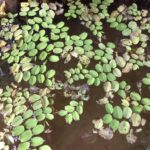
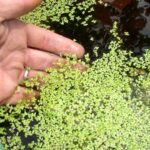
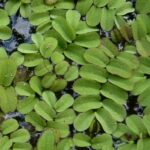
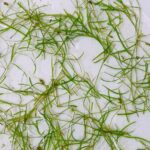

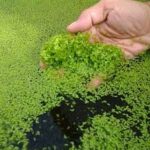
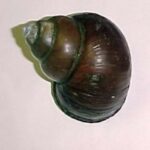
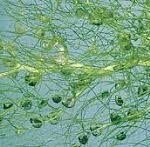
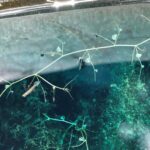
Please help stop the spread of invasive fresh water aquatic plants
ALWAYS inspect a pond before bringing any plants into Garden Ponds
If you suspect Invasives let us know
There are quite a few aquatic plants in the water gardening world that are considered invasive. Garden Ponds is proud to be an invasive-free nursery, and we spend a lot of energy making sure it stays that way. Over the years, we’ve learned a lot about how to deal with invasive aquatic plants. We have developed a strict quarantine process to cleanse our water gardens of any of these pesky plants.
What are invasive aquatic plants? They are water plants that thrive and multiply to the point of total take over.
To name a few:
- Bladderwort (Utricularia)
- Salvinia (Salviniaceae)
- Duckweed (Lemnoideae)
- Fairy Fern (Azolla)
- Pondweed (Stuckenia Pectinata)
- Water Lettuce (Pistia)
- Water Hyacinth (Eichhornia crassipes)
- Oil Weed (Muskgrass, Stonewort, Characeae, Chara)
They are all unique with their characteristics and require different methods of quarantine.
Salvinia stays at the surface, and is easy to remove from a water garden, but near impossible to remove from the riverways if even one piece gets in.
Duckweed fills the surface, is very small, and gets stuck in the other plants. It will float beneath the surface when you try to net it out. Duckweed invasions require a full container re-do to remove it. The same is required for invasions of bladderwort and pondweed, which only grow under the water’s surface.
How do invasive water plants spread? People can easily spread these plants by not being careful. Just a tiny piece of invasive plant material can spread like wildfire in a single body of water if it gets in. Some nurseries sell water plants that are riddled with invasives that you will take home with you. Also, if you have any invasives in a natural pond, they can be spread to streams and riverways if flooding in your area carries them away. Sometimes though, we have very little control over it because even a frog or a bird traveling from your neighbor’s pond into your pond can innocently spread invasive plants.
How do we control the spread of invasive pond plants? First, we educate our staff on what all the invasive species look like. If they are found, they are immediately marked to prevent further spread. To quarantine the water lilies, we take each water lily out of its pot and give it a 3-rinse bath with a thorough examination. We re-pot and place plants in a new water container; they are then placed under a 5-week quarantine observation. Nobody moves or sells them for 5-weeks, so we can make sure the invasive species don’t grow back.
Are there good invasive water plants? There are a couple of plants that are very helpful to some water gardens but are also considered invasive.
- Duckweed is high in protein and can be grown in controlled environments to feed fish such as tilapia.
- Oil weed (Muskgrass), or Chara Which is actually an algae and we have found to be great for keeping mosquitos out of shallow pots. If you’ve ever seen water hyacinth in the rivers, you can tell that it grows very invasive. However, this plant has the miraculous ability to pull excess nutrients and heavy metals out of the water and can sometimes turn your murky pond crystal clear in just a week or two. We are very careful to only use this algae in water containers to keep it from spreading into any rivers or natural ponds, and we are sure to tell our customers to keep the same protocol. Although it is a Very Fast reproducing algae, it is easy to scoop out of your containers, and lucky for us it makes amazing compost!
- Fairy Fern (Azolla) is also very nutrient-rich and used commonly for animal fodder, Azolla is nitrogen-fixing. (which is why it is so invasive, it creates its own food!) High in amino acids, beta carotene, vitamin a, vitamin B12, growth promoters intermediaries, and minerals. another great food source for tilapia.
Get help identifying Invasives in your water gardens
If you have any questions about potential invasive water plants in your water garden, take a picture and come down to Garden Ponds to show us. We are always happy to answer any questions you may have about your water garden.
How we clear invasive aquatic plants from ponds and containers we service and maintain
If we do maintenance on your pond regularly, we will have to remove any invasives we find so that we do not spread them to our other accounts. We use our standard quarantine rinse and repot process to save your plants and get rid of any invasives that they have been infested with. Some invasives are harder to get rid of than others, but most containers will have to be drained, rinsed, and refilled. If your bill is usually the same because we spend a consistent amount of time on maintenance, you may see an increase if we had to spend extra time during a visit for invasive-control. We will do our best to keep you informed, but it is most effective to act quickly when we see these problems so they do not become worse or spread to your other ponds.
“What is a weed? A plant whose virtues have not yet been discovered.”
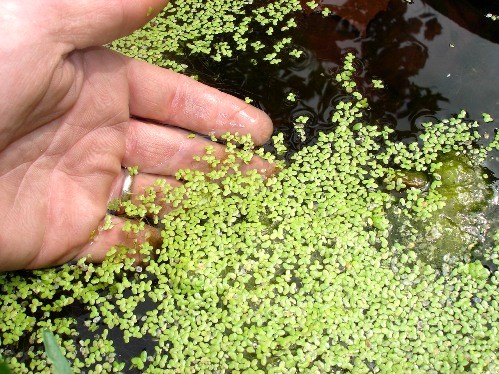

3 thoughts on “Invasive Aquatic Plants Of Hawaii”
Drain, repot and quarantine plants would be the major overhaul but it really depends on the invasive plant we are talking about. Send us a photo via email and we can help you proceed.
Comments are closed.